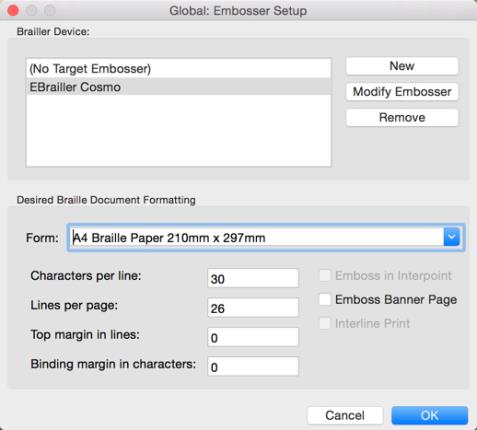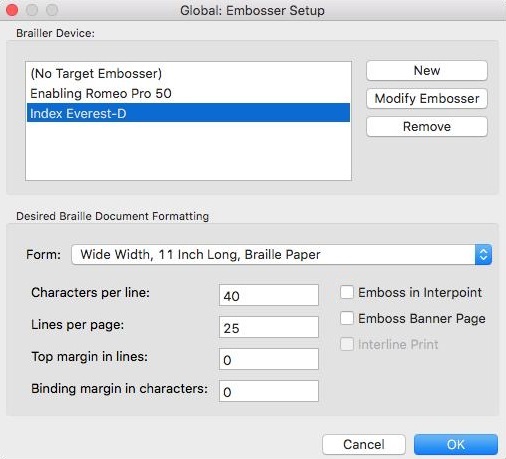
Keyboard: Select from Menu.
(Advanced Users - See also Editing the emb.elt file.)
Note: If your embosser does not have a USB port or your Macintosh has no serial or parallel port, see USB and Embossers for additional advice.
This menu function is intended to enable you to set up one or more embossers on your system, and to allow you to specify a default embosser for new documents. If you wish to modify the embosser settings for an individual document, (new or existing) you must do so in Document: Embosser Setup.
The Global: Embosser Setup dialog is used to tell DBT about your braille embosser. You must normally have at least one embosser (Brailler Device) set up on your system, and you may have as many as you like.


Brailler Device (Selection/List box): If your computer already has one or more embossers installed, they appear in this list. Otherwise the list only contains "(No Target Embosser)". To set one up, tab to the New button and press Enter.
New (button): This button takes you into the Embosser Setup dialog General tab, which is one of three tabs where you may begin the setup process. (If you are setting up a new embosser, you may wish to click on the above link now.)
Modify Embosser (button): Before you click this button, highlight the embosser you wish to edit in the Brailler Device selection list. This button also takes you to the Embosser Setup: General tab. (See Note #2.)
Remove (button): If you wish to remove an embosser, you must select it in the Brailler Device list first. You will be asked to confirm that you wish to remove the selected embosser as shown below. Press the Yes or No button as appropriate. (See Note #2.)


Desired Braille Document Formatting - This section contains form size and embossing controls. However, it is important to appreciate that entries here may be constrained by settings done previously in the Global: Embosser Setup: Device Settings tab. For example, if you have set a Top Margin of 2 in Device Settings, you cannot have a Top Margin of less than 2 in this section.
Form: Select the paper size you most commonly use with this brailler device. See "Forms: Size Definitions" for more details.
Characters per line: Enter your desired characters per line, excluding the binding margin.
Lines per page: Enter your desired lines per page, excluding the top margin.
Top margin in Lines: Enter your desired top margin in lines.
Binding margin in characters: Enter your desired binding margin in characters.
At the right are three check boxes which may be enabled depending on the capabilities of your selected embosser.
Emboss in Interpoint: This option is only available if your embosser supports Interpoint (double-sided) embossing.
Banner Page: This optional leader page gives basic file information; it can be embossed at the beginning of each job you output.
Interline Print: This option interleaves the print version of each embossed line for print-capable embossers.
If you are satisfied with your changes, press the OK button. If you do not OK your changes, they will not be saved.
If you wish to abort setting up this embosser, press the Cancel button.
#1: If you remove any Brailler Device, Perky Duck sets the Brailler Device to "(No Target Embosser)". In these circumstances, you can only set the Characters per Line and Lines per Page. In these fields you may only select between 10 and 160 Characters per line, and between 4 and 40 Lines per page.
#2: Besides being disabled when no embosser is selected, the Modify Embosser and Remove command buttons are disabled if a user will be unable to save changes to the configuration. Users without administrative access will find that these buttons remain disabled.
#3: Be aware that pressing OK in this main dialog not only confirms changes made here, but also any made in the General, Devices Settings, or Advanced dialog. However, within each sub-dialog, you must press OK before switching to another tab (say, from General to Device Settings) or your changes in the first tab will not be retained.
#4: Before leaving this dialog, ensure that you have highlighted the Brailler Device that you wish to be your default embosser for new documents. If you do not subsequently set a different embosser for an individual document, this will be your selected embosser.
#5: When you save a file, certain settings such as your selected embosser are "sticky document information" that remains with that file.
Templates also contain "sticky document information". If you commonly work with two or more paper sizes, you may want to create a custom template for each size.